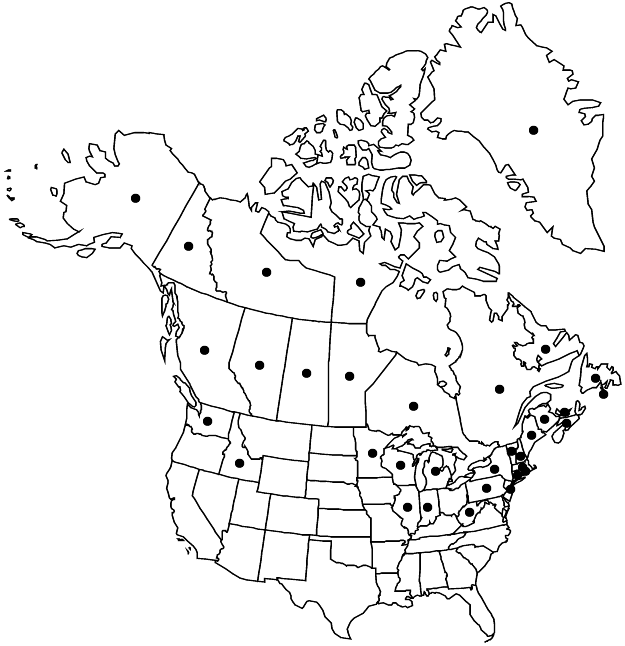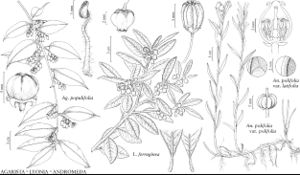Difference between revisions of "Andromeda polifolia"
Sp. Pl. 1: 393. 1753,.
FNA>Volume Importer |
FNA>Volume Importer |
||
| Line 21: | Line 21: | ||
|discussion=<p>Varieties 2 (2 in the flora).</p><!-- | |discussion=<p>Varieties 2 (2 in the flora).</p><!-- | ||
--><p>Infection of <i>Andromeda polifolia</i> by species of the ascomycete genus Rhytisma Fries appears to result in leaves broadened and reddish, often not glaucous (A. L. Jacquemart 1998).</p><!-- | --><p>Infection of <i>Andromeda polifolia</i> by species of the ascomycete genus Rhytisma Fries appears to result in leaves broadened and reddish, often not glaucous (A. L. Jacquemart 1998).</p><!-- | ||
| − | --><p>A hybrid of < | + | --><p>A hybrid of <i></i>var.<i> latifolia</i> with <i></i>var.<i> polifolia</i> [<i>Andromeda</i> ×jamesiana Lepage; <i>A. polifolia</i> var. jamesiana (Lepage) B. Boivin] is known from southern Nunavut and from the James Bay and southern Hudson Bay regions of Ontario and Quebec (J. Cayouette 1986); it is characterized by the abaxial surfaces of leaves being both glaucous and white-puberulent. Other specimens having abaxial surfaces of leaves both glaucous and puberulent are scattered through the range of <i>A. polifolia</i>.</p> |
|tables= | |tables= | ||
|references= | |references= | ||
| Line 44: | Line 44: | ||
-->{{#Taxon: | -->{{#Taxon: | ||
name=Andromeda polifolia | name=Andromeda polifolia | ||
| − | |||
|authority=Linnaeus | |authority=Linnaeus | ||
|rank=species | |rank=species | ||
| Line 56: | Line 55: | ||
|publication year= | |publication year= | ||
|special status= | |special status= | ||
| − | |source xml=https://jpend@bitbucket.org/aafc-mbb/fna-data-curation.git/src/ | + | |source xml=https://jpend@bitbucket.org/aafc-mbb/fna-data-curation.git/src/f50eec43f223ca0e34566be0b046453a0960e173/coarse_grained_fna_xml/V8/V8_985.xml |
|subfamily=Ericaceae subfam. Vaccinioideae | |subfamily=Ericaceae subfam. Vaccinioideae | ||
|genus=Andromeda | |genus=Andromeda | ||
Revision as of 22:33, 16 December 2019
Plants 5–80 cm, (without multicellular hairs); rootstocks creeping, ± horizontal. Leaf blades white-glaucous or, sometimes, green abaxially, (1–)2–5 cm × 1–8 mm. Pedicels erect or recurved, reddish or pale-glaucous, 6–20 mm. Flowers: sepals valvate in bud, soon wide-spreading, whitish to reddish, especially marginally, 1–1.7 mm, apex blunt to acute, calyx saucer-shaped, without stomata; petals short-spreading or recurved, hairy adaxially, minutely papillate on margins, corolla 5–8 × 3.5–7 mm, without stomata; nectariferous tissue at ovary base; ovary depressed-globose; placentae attached next to summit of columella; style ± equaling corolla tube. Capsules 5-locular, 4–8 × 4–5 mm, deeply depressed apically obscuring style base, conspicuously glaucous when young, glabrous or hairy at base. Seeds brown, ca. 1 mm; testa smooth, lustrous. 2n = 48.
Distribution

n North America, Europe, Asia.
Discussion
Varieties 2 (2 in the flora).
Infection of Andromeda polifolia by species of the ascomycete genus Rhytisma Fries appears to result in leaves broadened and reddish, often not glaucous (A. L. Jacquemart 1998).
A hybrid of var. latifolia with var. polifolia [Andromeda ×jamesiana Lepage; A. polifolia var. jamesiana (Lepage) B. Boivin] is known from southern Nunavut and from the James Bay and southern Hudson Bay regions of Ontario and Quebec (J. Cayouette 1986); it is characterized by the abaxial surfaces of leaves being both glaucous and white-puberulent. Other specimens having abaxial surfaces of leaves both glaucous and puberulent are scattered through the range of A. polifolia.
Selected References
None.
Key
| 1 | Leaf blades (1-)2-4 cm, abaxial surface white-glaucous (sometimes green), glabrous; corollas 5(-7) mm; corymbs 2-3(-4)-flowered, sometimes flowers solitary, erect or lax, on erect or ascending branchlets; pedicels 10-20 mm. | Andromeda polifolia var. polifolia |
| 1 | Leaf blades (2-)3-5 cm, abaxial surface not glaucous, white-hairy to white-velutinous; corollas 6(-8) mm; corymbs (2-)4-8-flowered, nodding, on curved branchlets; pedicels seldom more than 6-8 mm. | Andromeda polifolia var. latifolia |
